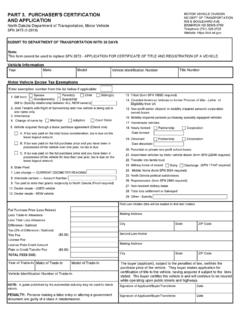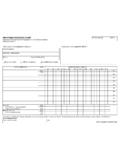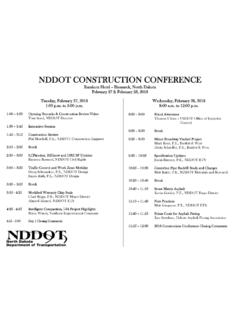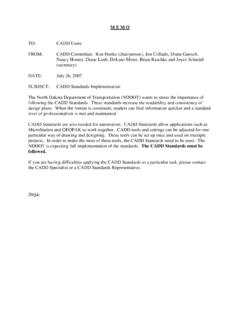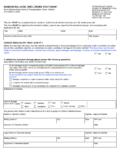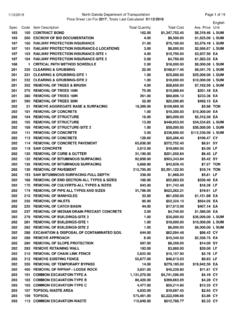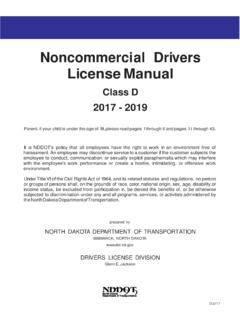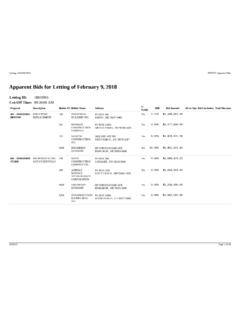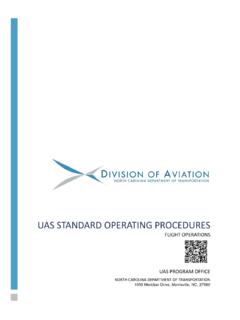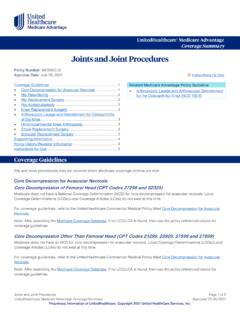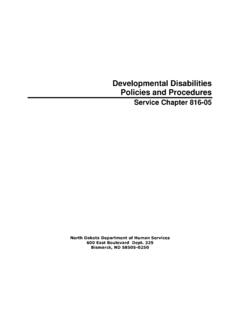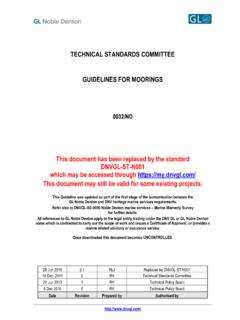Transcription of Test Procedures - North Dakota Department of …
1 FIELD SAMPLING AND TESTING MANUAL TESTING Procedures FOR ALL TESTS Intentionally Left Blank _____ 3/13/2019 Revised Procedures Page 1 of 2 TESTING Procedures FOR ALL TESTS TABLE OF CONTENTS ND T 2 Sampling Of Aggregates ND T 11 Materials Finer than No. 200 Sieve in Mineral Aggregates by Washing ND T 23 Making and Curing Concrete Test Specimens in the Field ND T 27 Sieve Analysis of Fine and Coarse Aggregates ND T 84 Specific Gravity and Absorption of Fine Aggregate ND T 85 Specific Gravity and Absorption of Coarse Aggregate ND T 87 Dry Preparation of Disturbed Soil and Soil Aggregate Samples for Test ND T 89 Determining the Liquid Limit of Soils ND T 90 Determining the Plastic Limit and Plasticity Index of Soils ND T 99/T 180 Moisture-Density Relations of Soils ND T 113 Lightweight Pieces in Aggregate ND T 119 Slump of Hydraulic Cement Concrete ND T 121 Density (Unit Weight), Yield, and Air Content (Gravimetric)
2 Of Concrete ND T 141 Sampling Freshly Mixed Concrete ND T 152 Air Content of Freshly Mixed Concrete by the Pressure Method ND T 166 Bulk Specific Gravity of Compacted Asphalt Mixtures Using Saturated Surface-Dry Specimens ND T 176 Plastic Fines in Graded Aggregates and Soils by Use of the Sand Equivalent Test ND T 191 Density of Soil In-Place by the Sand-Cone Method ND T 209 Theoretical Maximum Specific Gravity and Density of Hot Mix Asphalt _____ 3/13/2019 Revised Procedures Page 2 of 2 ND T 217 Determination of Moisture in Soils by Means of a Calcium Carbide Gas Pressure Moisture Tester (Speedy) ND T 224 Correction for Coarse Particles in the Soil Compaction Test ND T 245 Resistance to Plastic Flow of Bituminous Mixtures Using Marshall Apparatus ND T 248 Reducing Samples of Aggregate to Testing Size ND T 255 Total Evaporable Moisture Content of Aggregate by Drying ND T 265 Laboratory Determination of Moisture Content of Soils ND T 304 Uncompacted Void Content of Fine Aggregate ND T 309 Temperature of Freshly Mixed Hydraulic Cement Concrete ND T 312 Preparing and Determining Density of Hot Mix Asphalt (HMA)
3 Specimens by Means of the Superpave Gyratory Compactor ND T 318 Water Content of Freshly Mixed Concrete Using Microwave Oven Drying ND D 2167 Density and Unit Weight of Soil in Place by the Rubber-Balloon Method ND D 4643 Microwave Method of Drying Soils ND D 4791 Flat Particles, Elongated Particles, or Flat and Elongated Particles in Coarse Aggregate NDDOT 1 Sampling of Bituminous Materials NDDOT 2 DELETED 3/13/2019 NDDOT 3 Shale, Iron Oxide Particles, Lignite and Other Coal, Soft Particles, Thin or Elongated Pieces NDDOT 4 Percentage of Fractured Particles in Coarse Aggregate NDDOT 5 Sampling and Splitting Field Verification Hot Mix Asphalt (HMA) Samples NDDOT 6 Settlement Test for Liquid Membrane Curing Compound _____ND T 2 _____ 3/13/2019 Revised ND T 2 Page 1 of 4 ND T 2 SAMPLING OF AGGREGATES SCOPE This test defines the Procedures used to obtain samples that will show the nature and condition of the materials which they represent.
4 For equipment specification details consult the current AASHTO edition. REFERENCED DOCUMENTS AASHTO T 2, Sampling of Aggregates ND T 248 and AASHTO T 248, Reducing Samples of Aggregate to Testing Size TERMINOLOGY Maximum Size of Aggregate the smallest sieve opening through which the entire amount of aggregate is required to pass. Nominal Maximum Size the smallest sieve opening through which the entire amount of the aggregate is permitted to pass. Maximum Aggregate Size (SuperPave) one size larger than the nominal maximum aggregate size. Nominal Maximum Aggregate Size (SuperPave) one size larger than the first sieve that retains more than 10% aggregate. APPARATUS Containers, pails or bags Shovel Scoop or spoon Brush Sampling tubes TEST SPECIMEN The sample size is based on the type and number of tests to be performed.
5 The following table gives the approximate sample size required for different aggregate sizes. _____ND T 2 _____ 3/13/2019 Revised ND T 2 Page 2 of 4 SIZE OF SAMPLE Nominal Size of AggregateA Approximate Minimum Mass of Field SamplesB Fine Aggregate No. 8 ( mm) 25 lbs (10 kg) No. 4 ( mm) 25 lbs (10 kg) Coarse Aggregate 3/8" ( mm) 8 lbs ( 4 kg) 1/2" ( mm) 16 lbs ( 8 kg) 5/8" ( mm) 30 lbs (15 kg) 3/4" ( mm) 44 lbs (20 kg) 1" ( mm) 88 lbs (40 kg) 1 " ( mm) 132 lbs (60 kg) A For processed aggregate, use the nominal maximum size as indicated by the appropriate specification or description. If the specification or description does not indicate a nominal maximum size, use the maximum size (sieve indicating 100% passing). B For combined coarse and fine aggregates, , base or subbase, the minimum weight shall be the coarse aggregate minimums plus 25 lbs (10 kg).
6 PROCEDURE When practicable, samples shall be obtained from the finished product. Sampling requires a number of individual samples that are combined to make a composite sample. Reduce the sample to the required size by quartering or splitting in accordance with ND T 248. _____ND T 2 _____ 3/13/2019 Revised ND T 2 Page 3 of 4 SAMPLING FROM ROADWAY: When sampling from the roadway material or in-place, take samples from at least three approximately equal increments across the roadway. Obtain samples from the full depth of the course. Take care to avoid including material from the underlying subgrade or base course. Combine the samples to form a composite sample. SAMPLING FROM A FLOWING AGGREGATE STREAM: Obtain at least three approximately equal increments and combine to form the required size sample.
7 Collect the samples in a pan or by use of a sampling device. Take the samples from the entire cross section as it is being discharged. The receptacle should be of sufficient size to intercept the entire stream and hold the material without overflowing. SAMPLING FROM A WINDROW: Sample the windrow by removing the top one-foot of material and obtain part of the sample from each side. Avoid the segregated coarser material at the bottom of the side slope. Combine three samples to form a composite sample. SAMPLING FROM A CONVEYOR BELT: Obtain at least three approximately equal increments and combine to form the required size sample. Stop the conveyor belt and clean off a section of material from the belt. Insert a template that conforms to the shape of the belt. Carefully remove all the material from the template.
8 Use a scoop to remove as much of the material as possible. A brush and dustpan may be used to remove the fine material. Make sure to include all of the fine material. Space the three samples apart. SAMPLING FROM A STOCKPILE: Segregation often occurs when materials are stockpiled; therefore, it is difficult to ensure unbiased samples from stockpiles. For coarse or mixed coarse and fine aggregate, make every effort to enlist the services of power equipment to develop a separate, small sampling pile composed of material from various levels and locations in the main pile. Combine several increments to compose the sample. Where power equipment is not available, combine material from at least three increments: the top third, middle third, and bottom third of the pile. Insert a board vertically into the pile just above the sampling point to aid in preventing further segregation.
9 Remove the outer layer, which may be segregated, and sample the material beneath. _____ND T 2 _____ 3/13/2019 Revised ND T 2 Page 4 of 4 An alternate sampling method is to insert a sampling tube into the pile at a minimum of five random locations to extract material to form a sample. Sampling tubes are approximately 1 " (minimum) in diameter by 6' (minimum) in length SAMPLING FROM A TRUCK: For coarse aggregate or composite of coarse and fine aggregate, sample from trucks. Take samples from a minimum of three trenches. Dig trenches across the truck box at points on the surface that appear to be representative of the material. Make the trench bottom approximately level, at least one-foot wide and one-foot below the surface of the aggregate. Take equal portions of material by pushing the shovel downward into the material in the bottom of the trench at three equally spaced locations.
10 Do not scrape the material horizontally. Combine the nine portions (minimum) to form the combined sample from the truck. For sampling the fine aggregate, insert a sampling tube at a minimum of five locations. Sampling tube should be a minimum of 1 " in diameter by 6' in length. NOTES It is desirable to sample any material as near as possible to, if not at, the final in-place position. Hierarchies of preferred sampling locations are in-place, windrow, conveyor belt, flowing stream, truck box, or stockpile. 2/1 3/2015 Revised ND T 11 ___ _____ ND T 11 Page 1 of 3 ND T 11 - MATERIALS FINER THAN NO. 200 (75 m) SIEVE IN MINERAL AGGREGATES BY WASHING Conduct this procedure according to ND T 11.

